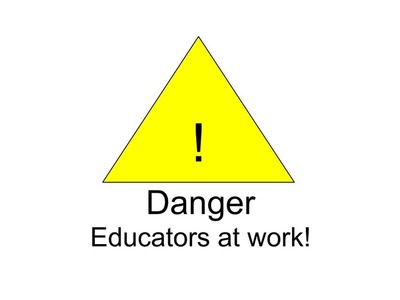The theme of the week is “
Producing Engaging and Effective Learning Materials“, with as a first task comparing learning resources, with three examples. As one can easily realise, since the content is completely different in each case, the comparison will be at the level of the style, organisation, choice of media and ways of involving learners. But let’s see what is proposed…
The first suggestion is to use one resource from Khan Academy’s YouTube videos. So, I chosen the “Introduction to Vectors and Scalars“:
Actually, a surprise! This introduction aims at clarifying the distinction between “vector” and “scalar”. If I have understood well: a scalar is a quantity (for example, a distance of 5m between two points) and the vector is a scalar associated to a displacement (for example, moving 5m to the right). It could be a bit more complex, introducing change of time, suggests the teacher. Then, he introduces a distinction between velocity (vector quantity, the move has a direction) and speed (scalar quantity, the direction is not specified). I am unsure of what will be the conceptions of vector and scalar that learners could develop after this lesson (e.g. what about scalars operating on vectors). So, the benefit from this staging of vectors can be discussed, but I recognise the power of the enchantment of the blackboard: the speed of the discourse regulated by that of the hand, the hesitations and small mistakes which gives the flavour of informal discourse, the always positive style: it might sound like very complicated ideas, but we will see in the course of the video that they are actually very simple ideas… (quasi verbatim). There is a kind of illusion of being close to the tutor, feeling that he is speaking to you. Well done! But still unsure about what could be the learning outcome…

So, now let’s move to the second example, taking one example from one resource from ElearningExamples e-learning games. Among the great many possibilities, I chosen the “Learning center for young astronomers“. This center gives access to several resources either texts or video, possibilities to navigate among resources. Some questions give opportunity for engaging in kind of interactions. The resource includes suggestions for use in the classroom. This is a classical environment for getting information along a not too boring journey in an encyclopaedia. It is not motivating by itself, but if learners have some motivation they may enjoy. I had a look on other resources of this set of examples, they are essentially game-like. The most difficult was to understand how learning is addressed. Games? yes, but learning… not obvious.

Eventually, I visited the iEthiCS simulation as suggested. The thing to emphasize is the clarity and the simplicity of the environment, and still an engaging style. Indeed, it is for adults and moreover medical students usually with a quite hight motivation towards case-based learning. After watching he video of the case, the student can make choices and get video commentaries (there is a text-based version). This is rather lively and efficient. The feeling of a contact with the tutor, although with little interaction (just decision choices), is realistic and convincing. This is a good video-based teaching.
So, now back to the task: “comparing resources”. To be frank, global comparisons is likely to be meaningless. But it is possible to make some on aspects shared by these resources. For example comparing the use of video by Khan Academy and iEthics, or the way learner’s navigation is framed by the Center for young astronomers and iEthics. All seems adapted to a certain conception of learners and of their autonomy, and they look quite well with their own style (that one may indeed always discuss). But an other question is whether they would succeed in “passing” the content they intend to give learners an access to. A question that #ocTEL does not ask, but the question which in the end is the most important. Khan academy treats knowledge as information so everything will depend on the listener, the Center for young astronomer does that too but in a more active way. Only iEthiCs treats knowledge as a tool for problem solving and not as information only, this is this which drives the design of the environment and it is, in my opinion, the key challenge of the design of TEL environments.
Eventually, the task includes a question about the extent to which these resources “differ from that of the resources we’re using in ocTEL?” There are two remarkable differences: these resources are rather focussed, while ocTEL is totally and vastly open (real risk to get lost), these resources target delivering some knowledge in some form, while ocTEL organizes exchanges of ideas and opinions about something which may be or not supported by some knowledge about TEL.I have not the feeling of following a course, but of being on a market place with a lot of possibilities. But it is hardly possible to identify what I am learning, and if there is something to learn beyond getting all these information.
Actually, we are touching there the main difficulty, challenge and weakness of TEL. So, my question: can TEL be taught or only learned?



